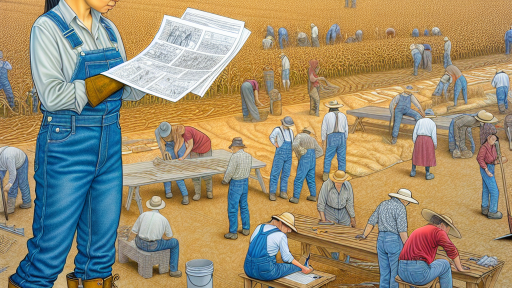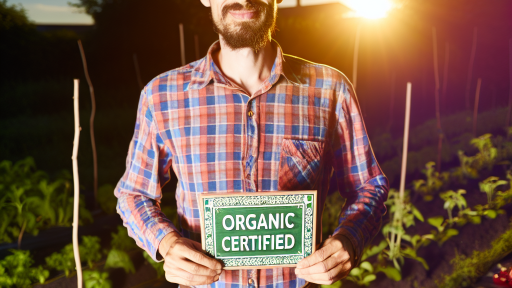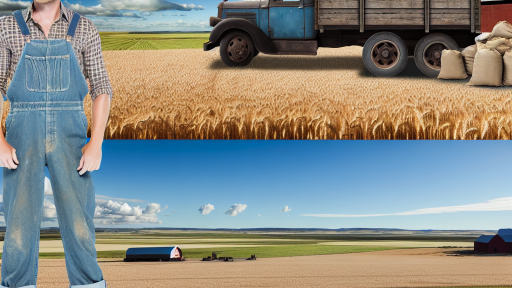Understanding the Nature of Trade Barriers in Agriculture
Defining Trade Barriers
Trade barriers refer to government-imposed restrictions on international trade.
These barriers can take various forms, including tariffs and quotas.
They serve to protect domestic industries from foreign competition.
Effective understanding is crucial for navigating global agricultural markets.
Types of Trade Barriers
Several key types of trade barriers affect agriculture.
- Tariffs, which impose a tax on imported goods.
- Quotas, which limit the quantity of a specific good that can enter a country.
- Subsidies, which support domestic farmers at the expense of foreign producers.
- Standards and regulations that must be met for imported goods.
Impact of Trade Barriers
Trade barriers can significantly impact agricultural production and pricing.
They can alter supply chains and affect the availability of goods.
Additionally, these barriers may lead to trade disputes between nations.
Consumers can ultimately face higher prices due to limited competition.
Case Studies of Trade Barriers
One example is the tariff on imported sugar imposed by the United States.
This tariff protects domestic sugar producers while raising costs for consumers.
Another example is the European Union’s restrictions on genetically modified organisms.
These regulations limit imports from countries that utilize these technologies.
Strategies for Managing Trade Barriers
A comprehensive strategy can help mitigate the effects of trade barriers.
- Engagement in trade negotiations is essential for finding common ground.
- Monitoring of policy changes helps businesses adapt to new regulations.
- Diversifying markets can reduce dependency on any single trade relationship.
- Investing in quality improvements can help products meet international standards.
Types of Trade Barriers
Tariffs
Tariffs are taxes imposed on imported goods.
Transform Your Agribusiness
Unlock your farm's potential with expert advice tailored to your needs. Get actionable steps that drive real results.
Get StartedThey raise the cost of foreign products for consumers.
This makes domestic products more competitive.
Governments use tariffs to protect local industries.
For instance, the U.S. may impose tariffs on certain crops.
Consequently, these tariffs can lead to trade disputes.
Quotas
Quotas limit the quantity of a specific product that can be imported.
They ensure that domestic producers remain competitive.
Countries often set quotas on agricultural products.
This approach can stabilize local markets.
For example, milk quotas regulate dairy imports in Europe.
However, quotas can also lead to shortages for consumers.
Non-Tariff Measures
Non-tariff measures encompass a range of regulations.
These include import licenses, quality standards, and health regulations.
Such measures can effectively limit imports without tariffs.
For instance, strict food safety regulations can restrict importation.
Moreover, these measures can protect consumer health.
On the other hand, they may also be misused for protectionism.
Effects on Global Trade
Trade barriers can disrupt global agricultural markets.
They may lead to retaliatory measures from trading partners.
This often results in a cycle of increased tensions.
In addition, barriers can inflate prices for consumers.
Ultimately, these trade policies can impact food security.
Therefore, managing trade barriers is crucial for stability.
The Impact of Trade Barriers on Domestic and Global Agriculture Markets
Understanding Trade Barriers
Trade barriers are government-induced restrictions imposed on international trade.
Showcase Your Farming Business
Publish your professional farming services profile on our blog for a one-time fee of $200 and reach a dedicated audience of farmers and agribusiness owners.
Publish Your ProfileThey include tariffs, quotas, and import bans.
These barriers aim to protect domestic industries and promote local agriculture.
However, they can distort market dynamics and increase prices.
Effects on Domestic Markets
Trade barriers directly affect domestic prices for agricultural goods.
For instance, tariffs on imported goods raise prices for consumers.
Additionally, these barriers can lead to reduced competition in local markets.
Farmers may benefit in the short term from less competition.
However, long-term reliance on protection can hinder innovation.
Impacts on Global Markets
Globally, trade barriers hinder market access for producers.
This can result in inefficiencies in food production and distribution.
In turn, it may lead to food shortages in regions heavily reliant on imports.
Countries facing trade barriers often struggle to meet consumer demand.
Moreover, these barriers can ignite trade disputes between nations.
Consequences for Food Security
Trade barriers can jeopardize food security worldwide.
Increased product prices lead to higher food costs for consumers.
This raises concerns for low-income populations relying on affordable food.
Consequently, nations may experience increased hunger and malnutrition.
Strategies for Managing Trade Barriers
Effective strategies can help mitigate the negative effects of trade barriers.
Nations can engage in trade negotiations to reduce tariffs.
Additionally, establishing free trade agreements fosters cooperation.
Supporting local farmers through subsidies can also promote resilience.
Finally, investing in sustainable agriculture enhances competitiveness.
Gain More Insights: Agricultural Employment Law Essentials
Strategies for Mitigating Trade Barriers
Diversifying Export Markets
Diversifying export markets helps reduce dependence on single markets.
This approach mitigates risks associated with trade barriers.
For example, Brazil expanded its agricultural exports to Asia.
By entering new markets, Brazil increased its resilience to trade disruptions.
Leveraging Trade Agreements
Trade agreements offer numerous benefits for agricultural trade.
Countries can negotiate reduced tariffs and improved access.
For instance, the USMCA enhances trade opportunities for North American farmers.
This agreement aims to streamline agricultural trade across borders.
Investing in Technology
Technology plays a crucial role in enhancing agricultural exports.
Advanced logistics and supply chain management improve efficiency.
Moreover, precision agriculture increases crop yields and quality.
These advancements can help farmers meet international standards.
Building Stronger Domestic Policies
Strong domestic policies support agriculture in a global market.
Subsidies and funding for research can enhance competitiveness.
Countries like Germany have implemented robust agricultural support systems.
Such policies foster innovation and resilience against trade barriers.
Case Studies from Around the World
Brazil’s Success in Asia
Brazil successfully built relationships in Asian markets.
Showcase Your Farming Business
Publish your professional farming services profile on our blog for a one-time fee of $200 and reach a dedicated audience of farmers and agribusiness owners.
Publish Your ProfileThese efforts led to increased soybean and beef exports.
Consequently, Brazil demonstrated the impact of market diversification.
Canada’s Trade Policy Adjustments
Canada revised its trade policies to better access Asian markets.
These adjustments have strengthened the agricultural sector significantly.
Canada’s commitment to trade agreements paid off during tariffs disputes.
Adoption of New Technologies in the Netherlands
The Netherlands excelled in using technology for agricultural exports.
Investments in greenhouse farming optimize resource usage.
This innovation has boosted their agricultural export capabilities worldwide.
Delve into the Subject: Understanding GMO Farming Regulations for Better Yields
The Role of Governments and Policies in Managing Trade Barriers
Understanding Trade Barriers
Trade barriers refer to government-imposed restrictions on international trade.
They can take various forms, including tariffs, quotas, and import bans.
Governments implement these barriers to protect domestic industries and jobs.
However, such measures can also hinder free trade and increase prices for consumers.
The Impact of Tariffs
Tariffs are taxes imposed on imported goods, making them more expensive.
High tariffs encourage consumers to buy domestic products instead of imports.
For example, the U.S. tariffs on steel imports have affected various industries.
While tariffs can protect local jobs, they can also provoke retaliation from other nations.
Quotas and Their Implications
Quotas limit the amount of a specific good that can be imported.
These measures ensure that local producers maintain a certain market share.
For instance, the European Union uses quotas on sugar imports to protect its farmers.
However, quotas can also result in shortages and higher prices for consumers.
Government Subsidies
Governments may subsidize local farmers to enhance their competitiveness.
Subsidies allow farmers to sell products at lower prices than foreign competitors.
Consequently, this practice can lead to trade disputes with other nations.
The World Trade Organization regulates subsidies to maintain fairness in trade.
Negotiating Free Trade Agreements
Countries pursue free trade agreements to lower or eliminate trade barriers.
These agreements promote trade by establishing favorable terms between nations.
For example, NAFTA facilitated extensive trade between the U.S., Canada, and Mexico.
Such agreements often include clauses to protect against unfair trade practices.
The Role of International Organizations
International organizations play a significant role in trade policy management.
The World Trade Organization facilitates negotiations to reduce trade barriers.
It also monitors member countries’ compliance with trade regulations.
Moreover, these organizations provide arbitration in trade disputes between nations.
Addressing Domestic Concerns
Governments must balance trade policies with domestic interests.
They often face pressure from local industries affected by foreign competition.
This pressure can lead to calls for more stringent trade barriers.
Consequently, policymakers must consider both economic and social implications.
Delve into the Subject: Protecting Farm Workers Legal Guidelines

Technological Innovations and Their Influence on Overcoming Trade Barriers
Enhanced Communication Technologies
Modern communication tools simplify the exchange of information.
Farms utilize real-time data sharing to coordinate logistics effectively.
Showcase Your Farming Business
Publish your professional farming services profile on our blog for a one-time fee of $200 and reach a dedicated audience of farmers and agribusiness owners.
Publish Your ProfileThese technologies also facilitate transparent negotiations among stakeholders.
Furthermore, they enable quick resolution of trade disputes.
Precision Agriculture Techniques
Precision agriculture improves input efficiency for farmers.
Farmers can apply resources like water and fertilizers more strategically.
This optimization enhances crop yield and quality.
As a result, farmers can meet international standards more easily.
Blockchain for Supply Chain Transparency
Blockchain technology ensures traceability in agricultural products.
It allows consumers to verify the source of their food.
This transparency builds consumer trust and preference.
As a result, producers can overcome skeptical trade barriers.
Innovations in Transportation
Advancements in transportation technologies expedite product delivery.
Logistics software plays a crucial role in optimizing routes.
Additionally, refrigeration advancements maintain product quality during transit.
These innovations effectively reduce spoilage rates and costs.
Data Analytics for Market Insights
Data analytics provides valuable insights into market trends.
Farmers can adjust their strategies based on consumer preferences.
Such insights lead to improved competitiveness in global markets.
Consequently, businesses can anticipate changes in trade policies.
Collaboration with Tech Companies
Collaboration between farmers and tech companies fosters innovation.
Startups are creating cutting-edge agricultural solutions.
Incubators are providing resources for farmers to adopt new technologies.
These partnerships are crucial for developing sustainable practices.
Explore Further: Addressing Wage Theft in Agriculture
Negotiating Trade Agreements: Best Practices and Lessons Learned
Understanding the Importance of Trade Agreements
Trade agreements are crucial for agricultural success.
They help reduce trade barriers that limit market access.
Moreover, these agreements foster better trade relations between nations.
Preparation for Negotiations
Preparation is vital before entering negotiations.
Researching the needs of domestic producers is essential.
Stakeholder engagement can reveal critical insights.
Additionally, setting clear objectives helps guide the negotiation process.
Developing a Negotiation Strategy
A strong negotiation strategy is key to achieving desired outcomes.
Identify priorities and areas where compromise is acceptable.
Plan for various scenarios that may arise during the talks.
Ultimately, a flexible approach can lead to fruitful agreements.
Building Relationships with Counterparts
Building trust with negotiating counterparts enhances collaboration.
Open communication fosters mutual understanding and respect.
Regular meetings with foreign partners can strengthen relationships.
Additionally, acknowledging cultural differences promotes positive interactions.
Utilizing Data and Evidence
Data-driven negotiations provide a solid foundation for arguments.
Using statistical evidence helps substantiate claims during discussions.
Showcase Your Farming Business
Publish your professional farming services profile on our blog for a one-time fee of $200 and reach a dedicated audience of farmers and agribusiness owners.
Publish Your ProfileFurthermore, industry reports can offer valuable insights into trends.
Employing data enhances credibility and persuasiveness in negotiations.
Learning from Past Negotiations
Reflecting on previous negotiations offers valuable lessons.
Analyzing what worked and what didn’t can inform future strategies.
Moreover, gathering feedback from team members can provide diverse perspectives.
Ultimately, continuous improvement leads to more effective negotiations.
Adapting to Changing Conditions
Flexibility is crucial in responding to shifting political climates.
Trade policies may change, requiring quick adaptation.
Moreover, external economic factors can impact negotiations significantly.
Staying informed about global trends helps in making timely adjustments.
Fostering Public Support
Public support is critical for successful trade negotiations.
Engaging with the community helps in building understanding.
Moreover, communicating the benefits of agreements fosters goodwill.
Transparent processes enhance trust and collaboration across stakeholders.
Future Trends: How Globalization and Sustainability are Shaping Trade Barriers in Agriculture
The Impact of Globalization
Globalization significantly affects agricultural trade barriers.
It facilitates trade by reducing tariffs and quotas.
Consequently, this encourages international competition.
Farmers now compete on a global scale, affecting local markets.
Similarly, global supply chains create new opportunities for producers.
However, they also introduce vulnerabilities to external shocks.
Sustainability and Trade Policies
Sustainability increasingly influences agricultural trade policies.
Governments prioritize environmental protection in trade agreements.
They often impose stricter standards on imported goods.
This approach protects local agricultural practices.
Moreover, it promotes sustainable farming methods worldwide.
Technological Advancements
Technology plays a vital role in managing trade barriers.
For instance, data analytics enhances supply chain efficiency.
Additionally, digital platforms simplify cross-border transactions.
This innovation reduces costs and increases market access.
As a result, farmers can respond quickly to global demands.
Consumer Preferences Driving Change
Consumer preferences significantly shape agricultural trade barriers.
There is a rising demand for organic and locally sourced products.
Retailers adjust their sourcing strategies accordingly.
This shift encourages producers to adopt sustainable practices.
Consequently, trade policies also evolve to meet these preferences.
Future Challenges and Opportunities
Globalization and sustainability present both challenges and opportunities.
Trade tensions can arise from competitive disparities among countries.
Consequently, nations may adopt protectionist policies.
On the other hand, collaboration can lead to innovative solutions.
For instance, countries may develop joint sustainability initiatives.
Showcase Your Farming Business
Publish your professional farming services profile on our blog for a one-time fee of $200 and reach a dedicated audience of farmers and agribusiness owners.
Publish Your ProfileMoreover, public-private partnerships can enhance agricultural trade.
Additional Resources
Food Safety and Trade: Regulations, Risks, and Reconciliation …
U.S. Agriculture Secretary Tom Vilsack Highlights Key Work in 2021 …




